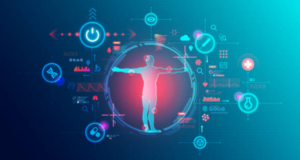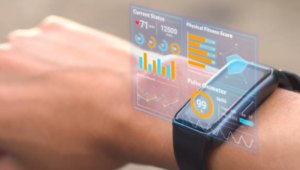Empowerment vs. Surveillance

In today’s digital age, technology has seamlessly integrated into every facet of our lives, including our pursuit of beauty and wellness. Wearable health tech, such as fitness trackers, smartwatches, and health monitoring devices, has revolutionized how we approach self-care. These gadgets promise empowerment by providing valuable insights into our health and fitness levels. However, they also raise concerns about privacy invasion and surveillance. In this blog, we’ll delve into the double-edged sword of wearable health tech, exploring both its empowering benefits and the potential pitfalls of increased surveillance.
Empowerment Through Data
Wearable health tech has revolutionized the way individuals approach their beauty and wellness routines by providing a wealth of data-driven insights. These devices offer a comprehensive overview of various aspects of health, including physical activity, sleep quality, stress levels, and even skincare metrics. Let’s explore some of the specific ways in which wearable health tech empowers users:
- Physical Activity Tracking: Wearable fitness trackers and smartwatches monitor metrics such as step count, distance traveled, and calories burned throughout the day. These devices provide users with real-time feedback on their activity levels, motivating them to meet daily fitness goals. For beauty enthusiasts, maintaining an active lifestyle is essential for promoting overall health and enhancing skin radiance. By tracking physical activity, individuals can ensure they’re getting enough movement to support their skincare goals.
- Sleep Quality Monitoring: Adequate sleep is crucial for skin health and overall well-being. Wearable devices equipped with sleep tracking capabilities monitor the duration and quality of sleep, including factors like sleep stages, interruptions, and overall sleep efficiency. By analyzing this data, users can identify patterns and make adjustments to improve their sleep hygiene. Better sleep quality can lead to reduced dark circles, improved skin elasticity, and a more refreshed complexion.
- Stress Management: Chronic stress can wreak havoc on skin health, leading to inflammation, breakouts, and premature aging. Wearable health tech devices now offer features like stress tracking and relaxation exercises to help users manage stress levels effectively. By monitoring heart rate variability and other biometric indicators, these devices provide insights into stress levels throughout the day. Additionally, guided breathing exercises and mindfulness prompts offer practical strategies for reducing stress and promoting skin wellness.
- Nutrition and Hydration Tracking: Proper nutrition and hydration are essential for maintaining healthy skin from the inside out. Some wearable health tech devices allow users to track their dietary intake and hydration levels, providing personalized recommendations based on individual goals and preferences. By monitoring nutrient intake, individuals can ensure they’re fueling their bodies with the essential vitamins and minerals needed for radiant skin. Likewise, tracking hydration levels helps maintain skin moisture and elasticity, reducing the risk of dryness and irritation.
- Skincare Analysis and Recommendations: The integration of wearable health tech with skincare devices and applications offers personalized skincare analysis and recommendations. Some devices use sensors to assess skin hydration levels, oiliness, and other factors, providing tailored product recommendations and skincare routines. By leveraging technology, individuals can address specific skin concerns more effectively and achieve better results from their skincare regimen.
- Goal Setting and Progress Tracking: One of the most powerful features of wearable health tech is its ability to facilitate goal setting and progress tracking. Users can set personalized health and beauty goals, such as increasing daily steps, improving sleep quality, or maintaining a consistent skincare routine. These devices provide visual representations of progress over time, motivating users to stay committed to their goals and celebrate their achievements along the way.

Surveillance and Privacy Concerns
While wearable health tech offers numerous benefits, including empowerment through data insights, it also raises significant concerns regarding privacy and surveillance. These concerns stem from the vast amounts of personal data collected by these devices, including biometric information, activity patterns, and even location data. Here are some of the key privacy and surveillance concerns associated with wearable health tech:
- Data Collection and Storage: Wearable health tech devices continuously collect and store vast amounts of personal data, ranging from biometric information like heart rate and sleep patterns to activity data such as step count and exercise routines. This data is often transmitted to companion apps or stored in the cloud for analysis and long-term tracking. The sheer volume and sensitivity of this data raise concerns about potential misuse or unauthorized access.
- Third-Party Access and Data Sharing: Many wearable health tech companies partner with third-party service providers to analyze and monetize user data. While these partnerships may offer additional features or insights, they also raise questions about data security and privacy. Users may inadvertently consent to sharing their personal health data with advertisers, researchers, or other third parties, leading to potential privacy breaches or targeted marketing efforts.
- Security Vulnerabilities and Hacking Risks: The interconnected nature of wearable health tech makes it susceptible to security vulnerabilities and hacking risks. Malicious actors may exploit weaknesses in device firmware, companion apps, or cloud storage systems to gain unauthorized access to sensitive user data. A data breach could expose personal health information, activity patterns, and even location data, putting users at risk of identity theft, financial fraud, or other forms of harm.
- Surveillance Capitalism and Targeted Advertising: The monetization of personal data has given rise to the concept of surveillance capitalism, whereby companies profit from the collection and analysis of user behavior. Wearable health tech companies may leverage user data to deliver targeted advertising or personalized marketing campaigns based on individual health and lifestyle preferences. While targeted advertising may seem innocuous, it can erode privacy and autonomy by commodifying personal health information for commercial gain.
- Health Insurance and Employment Discrimination: The proliferation of wearable health tech raises concerns about potential discrimination based on health or lifestyle choices. Employers or health insurance companies could use data collected from wearable devices to assess risk profiles or make decisions about coverage eligibility. This could lead to discrimination against individuals with pre-existing health conditions or those who choose not to participate in health monitoring programs, infringing upon their privacy and autonomy.
- Accuracy and Reliability: The accuracy and reliability of data collected by wearable health tech devices have also been called into question. Studies have shown discrepancies between the data collected by these devices and medical-grade equipment, raising concerns about the validity of the insights they provide. Relying on inaccurate data could lead to misguided decisions regarding health and beauty practices, potentially causing harm rather than benefit.

Finding Balance
In navigating the complexities of wearable health tech, finding a balance between harnessing its benefits and safeguarding personal privacy and autonomy is crucial. Here are some key considerations for striking that balance effectively:
- Informed Consent and Transparency: Users must have a clear understanding of the data collected by wearable health tech devices and how it will be used. Companies should provide transparent disclosures about data collection practices, processing purposes, and any third-party sharing arrangements. This transparency enables users to make informed decisions about whether to consent to data collection and sharing, empowering them to assert control over their personal information.
- Granular Privacy Controls: Providing users with granular privacy controls allows them to tailor their preferences according to their comfort level and privacy preferences. This may include options to opt out of certain data collection features, adjust sharing settings, or delete collected data. By empowering users to customize their privacy settings, companies demonstrate respect for user autonomy and promote a sense of trust and transparency.
- Data Minimization and Purpose Limitation: Adopting principles of data minimization and purpose limitation helps mitigate privacy risks associated with excessive data collection and processing. Companies should only collect data that is necessary for fulfilling specific purposes, such as providing health insights or improving device functionality. Additionally, data should be retained only for as long as necessary to achieve these purposes, minimizing the risk of unauthorized access or misuse.
- Security by Design: Incorporating security by design principles into the development and implementation of wearable health tech devices helps protect user data against security threats and vulnerabilities. This includes implementing robust encryption protocols, securing data storage and transmission channels, and regularly updating software to patch known vulnerabilities. By prioritizing security from the outset, companies can build trust with users and mitigate the risk of data breaches or unauthorized access.
- User Education and Empowerment: Educating users about the privacy implications of wearable health tech and providing resources for managing their privacy settings is essential for promoting user empowerment. Companies should offer clear, accessible information about privacy best practices, data security measures, and user rights. Additionally, providing user-friendly interfaces and educational materials empowers users to make informed decisions about their privacy and take proactive steps to protect their personal information.
- Regulatory Compliance and Accountability: Compliance with relevant privacy regulations and standards, such as GDPR, HIPAA, or the California Consumer Privacy Act (CCPA), is essential for ensuring legal and ethical data practices. Companies should establish robust compliance programs, conduct regular privacy assessments, and appoint dedicated privacy officers to oversee data governance and compliance efforts. By demonstrating a commitment to regulatory compliance and accountability, companies can build trust with users and mitigate legal and reputational risks.
- Ethical Considerations and Stakeholder Engagement: Engaging with stakeholders, including users, advocacy groups, policymakers, and industry peers, is critical for addressing ethical considerations and promoting responsible data practices. Companies should solicit feedback from diverse perspectives, conduct impact assessments to identify potential risks and benefits, and incorporate ethical considerations into decision-making processes. By fostering a culture of ethical responsibility and accountability, companies can navigate the complex landscape of wearable health tech while upholding user trust and societal values.

Wearable health tech presents a double-edged sword for beauty enthusiasts, offering empowerment through data insights while raising concerns about privacy and surveillance. By harnessing the benefits of these devices while safeguarding personal privacy, individuals can take control of their health and beauty routines in a digitally connected world. As technology continues to evolve, it’s crucial to prioritize transparency, accountability, and user autonomy to ensure that wearable health tech remains a tool for empowerment rather than surveillance.




